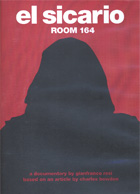
El Sicario, Room 164 2011
Distributed by Icarus Films, 32 Court St., 21st Floor, Brooklyn, NY 11201; 800-876-1710
Produced by Serge Labou, Gianfranco Rosi
Directed by Gianfranco Rosi
DVD, color, 84 min.
College - General Adult
Crime, Latin American Studies
Date Entered: 06/04/2012
Reviewed by Brian Falato, University of South Florida Tampa Campus LibraryIn room 164 of an unidentified motel on the U.S.-Mexican border, a man puts on a black mesh hood to obscure his face. Suitably disguised, he then tells his story of working for 20 years as a kidnapper, torturer, and killer for Mexican drug traffickers.
The man is known only as “El Sicario.” As explained on the DVD container, sicario derives from the name of a Jewish sect in Roman Palestine, the Sicarii, who used concealed daggers called sicae to murder Romans and their supporters. A sicario for drug traffickers, says the man in the video, is a professional who goes about his work with a minimum of show. He lives a quiet life when not working for drug traffickers.
The techniques used in kidnapping, torturing, and murdering are laid out in sometimes alarming detail by this sicario. He has little to fear from the Mexican police and legal officials, he says, because bribery is so endemic. And sometimes, as in the case of this sicario, those hired by drug traffickers to commit these crimes also work as police officers.
The sicario started working for the drug cartels while in high school. He drove cars loaded with drugs over the border into El Paso, Texas. Cartel influence got him into the police academy, even though he didn’t meet the qualifications. The knowledge he gained at the police academy later helped him as he moved into more violent criminal activities. The traffickers see the academy as a great recruiting ground, he says.
A sicario’s work takes its toll on a person’s psyche. “You have to stay high and drunk all the time to overcome scruples” about doing the job, he says. The beginning of the end of his time as a sicario was when he kept some of the money he received as payment for a debt and went on a drug and alcohol binge. Retaining even a small portion of the money he collected was a breach of trust with the traffickers, and he became a marked man.
A religious conversion has led to a new life for the sicario, but he still must live as a fugitive. Although he has never been charged with a crime in either the U.S. or Mexico, the traffickers have a $250,000 price on his head.
This video, based on a Harper’s magazine article by Charles Bowden, is shot almost entirely in the motel room. There are only a few shots outside the room, used as establishing shots or transitions. This doesn’t lead to boredom, however, because of the riveting nature of the story told. The sicario can get quite animated as he relates some episodes, and he uses a sketch pad and marker to illustrate and emphasize some points. This documentary is a chilling look at one aspect of the drug trade and why it is so successful, and is recommended.